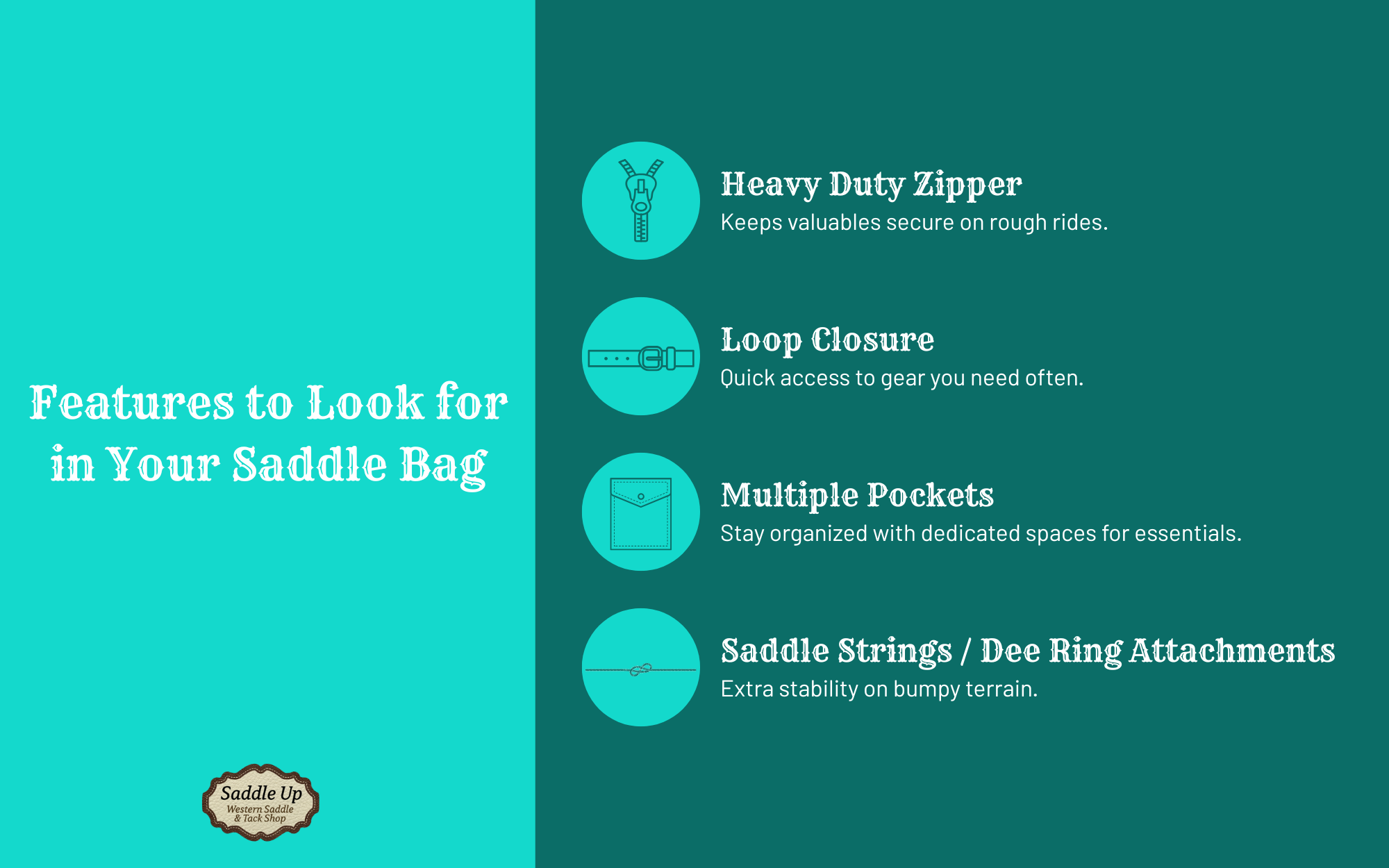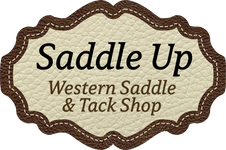Packing Western Saddle Bags: Essentials for Every Ride
Posted by Saddle Up on Aug 26th 2025

From short rides to multi-day pack trips, packing your saddle bag correctly ensures you have everything you need for comfort, safety, and convenience. The right setup keeps you organized, your horse comfortable, and your gear protected.
Choosing the Right Saddle Bag
Selecting the right saddle bag depends on the type of riding you do, how much you carry, and where you place it on your saddle. Here are some common types and how they’re used.

Bag Types and Placement
Horn Bag or Pommel Bag
- Attaches to the saddle horn and sits over the pommel.
- Ideal for easy access to small items like a cell phone, snacks, or water bottles without dismounting.
- Perfect for short rides when you only need the basics.
- Some will have extra straps to more securely attach them over the pommel of the saddle for less bounce.
Cantle Bag
- Attaches behind the seat or the cantle, making it useful for bulkier essentials like rain gear, a saddle cover, or a spare layer.
- Works well for both short and longer rides.
Saddle Bag
- A variation of the cantle bag, designed for extra storage.
- Useful for pack trips when you need additional room for fly masks, first-aid supplies, food and water, multi-tools, and personal items like keys or sunscreen.
Canvas Saddle Bag
- Made from breathable, sturdy fabric.
- Offers good durability and is a solid choice for riders who want a classic look without the weight of leather.
Leather Saddle Bag
- A timeless style with exceptional durability when made from high-quality material.
- Leather can handle years of use with proper care.
Synthetic Materials
- Options made from synthetic materials are lightweight, water-resistant, and often feature nylon webbing for reinforcement.
- Popular for riders who want less weight on the horse.
Key Features to Look For
- Heavy-duty zipper closures for security.
- Loop closure for quick access compartments.
- Multiple pocket designs for organized packing.
- Saddle strings or dee ring attachments for stability.
- Durability that matches your riding frequency and terrain.
- Insulated bags for keeping food and water cool.
Matching to Your Riding Style
For short trail rides, a horn bag or pommel bags might be enough. For a pack trip or extended horseback riding adventure, combine a cantle bag or larger saddle bags with extra-large side pockets.
If you use a pack horse, pack saddle or even a donkey or mule for hauling gear, larger saddle bags or Pack Panniers in synthetic materials or leather can carry heavier loads securely.
The Essentials for Your Saddle Bag
Packing well means thinking about both you and your horse. Here’s what to consider for different needs.
For Rider Comfort & Safety
- Water bottles in an easy-access spot, like a horn bag.
- Snacks for quick energy during a trail break.
- Navigation tools such as maps, GPS, or your cell phone in a waterproof pocket.
For Horse Care on the Trail
- Fly mask and fly spray to protect from insects.
- Hoof pick for clearing debris from horse's hooves
- Small first aid kit for you and your horse.
- Spare halter or lead rope in case of equipment failure.
- Tree line or nylon rope and leather saddle strings for emergency situations
For Weather & Gear Protection
- Rain gear for the rider.
- Saddle cover to protect leather or synthetic materials from moisture.
- Lightweight blanket for the horse or donkey in cooler conditions.
Other Items You Might Need
- Cell phone, wallet, and ID in a secure pocket.
- Small camera or binoculars for sightseeing on the trail.
Packing Tips for Balance and Easy Access
A well-packed western saddle bag is all about placement, balance, and accessibility.
- Distribute weight evenly between pommel bags and cantle bags to prevent strain on the horse.
- Keep frequently used items like snacks or your cell phone in easy-access compartments.
- Use loop closure pockets for gear you reach for often, and heavy-duty zipper pockets for valuables or gear that must stay secure.
- Select synthetic materials for wet climates and leather saddle bag designs for dry or moderate climates.
- Attach with saddle strings or to a dee ring for stability on rough terrain.
- Ensure a perfect fit for your western saddle bag so it doesn’t rub or shift during the ride.
Maintaining Your Saddle Bags for Long-Term Use
The lifespan of your saddle bag depends on regular care.
- Leather saddle bag: Clean with a damp cloth and leather cleaner after each ride, condition with leather oil periodically, and store in a cool, dry place.
- Canvas saddle bag: Brush off dirt, spot clean with mild soap, and dry completely before storing.
- Synthetic materials: Rinse with water, check seams and nylon webbing for wear, and repair promptly.
- Inspect heavy-duty zippers and loop closure systems regularly.
- Store bags with a saddle cover to protect from dust and sunlight.
- Replace worn bags before a pack trip to prevent mid-ride failures.
For western tack and horse saddle bags that deliver on style, durability, and function, visit Saddle Up Colorado’s online store. You’ll find options in leather, canvas, and synthetic materials, all designed for the rider who values quality and the horse who deserves comfort.
Be Ready for Every Ride
A well-packed western saddle bag keeps both you and your horse prepared for anything the trail throws your way. Choosing the right bag type, organizing for balance, and investing in high-quality material pays off in comfort, safety, and peace of mind. Whether you’re out for an afternoon trail ride, embarking on a week-long pack trip, or using a pack saddle with a trusty donkey, the right packing strategy ensures you and your horse enjoy the journey.
At Saddle Up Colorado, we help you find the perfect fit for your riding needs, from leather saddle bags to canvas saddle bags, pommel bags to cantle bags. Our team is ready to guide you to the gear that will serve you for years – because every ride deserves a well-packed saddle.
